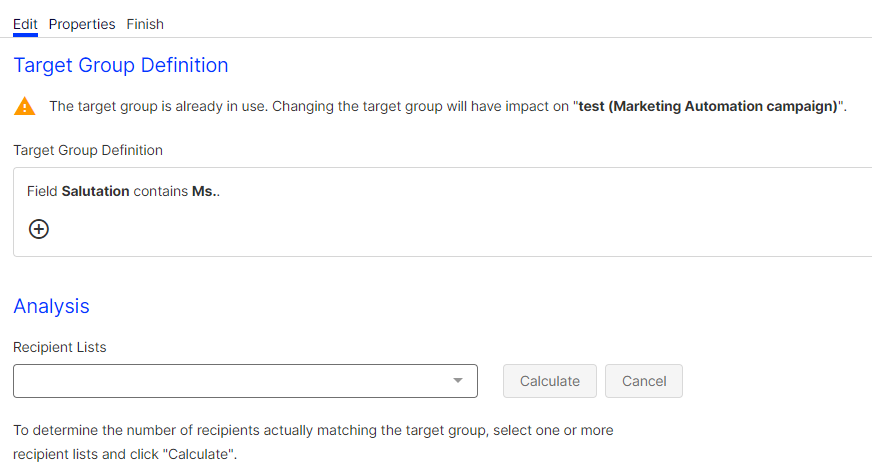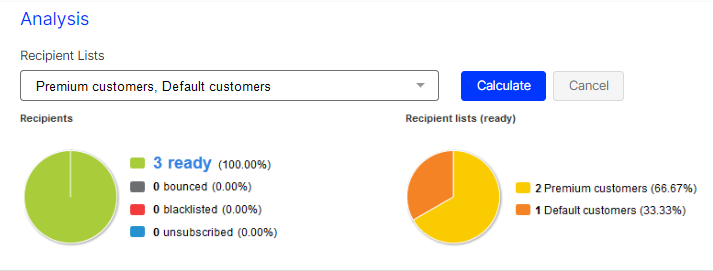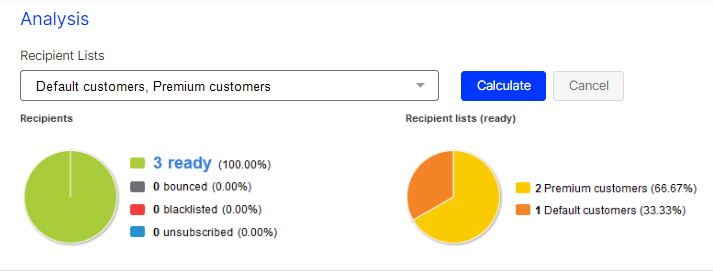 Target group analysis
Target group analysis
The target group Subset of recipients defined by rules and conditions and a logic relationship between them. For example, all recipients in the United Kingdom. analysis lets you check a target group for correct functionality. You can check how many recipients from recipient lists the target group definition matches. You can also change the definition, if necessary, before sending the mailing.
- Open the Optimizely Campaign menu and select Recipients > Target Groups.
- Select a target group and click Analysis….
- In the Recipient List drop-down list, select one or more recipient lists for which you want to perform the target group analysis.
Ensure that all selected recipient lists have at least one media type in common. If several lists with more than one media type in common are selected, then select which media type represents the marketing channel Channel through which advertising messages or information are transmitted to customers and prospects. For example, email, SMS, print or push.. For example, if you want to send emails, then select the media type Email.

- If you use a default target group but you do not want this to be included in the calculation, select Disable default target group for this calculation.
- Click Calculate. The calculation is started in the background. If the analysis is completely calculated, the graphical analysis is displayed.
The analysis contains the following information:
- Recipients. Displays all recipients of the selected recipients lists that match the target group. The recipients are sorted by the following categories:
- ready. Matches the target group and ready for dispatch. You can send mailings to these recipients.
- bounced. Matches the target group but is not ready for dispatch, because they are too many bounces Hard bounces occur when an email cannot be delivered due to a permanent error (for example because the email address no longer exists)..
- blocked. Matches the target group but is not ready for dispatch, because they are blocked Recipients whose email addresses are on the blocklist will never again receive email from you. This applies even if recipients subscribe to newsletters again later. To reverse this status, remove the recipient from the blocklist..
- unsubscribed. Matches the target group but is not ready for dispatch, because they are unsubscribed.
- Recipient Lists (Ready). Displays the number of recipients of the corresponding recipient lists that match the target group and can send a mailing to; recipients that create too many bounces, that are blocked, or unsubscribed are not taken into account here.
If you want to change the target group, because it does not match the desired number of recipients, edit the definition and perform the analysis again.
- Recipients. Displays all recipients of the selected recipients lists that match the target group. The recipients are sorted by the following categories:
- If the Example recipients feature is enabled in your client The working environment of Optimizely Campaign. A client is a stand-alone and closed system that serves to organize your mailings. Campaign users can use one or more clients for your scenario., after the analytical calculation you can display sample recipients (up to 100 datasets) that meet the target group definition. To do so, click Example recipients. A window with up to 100 sample recipients opens.
To enable the Example recipients feature, you need the consent of your recipients to view and use personal data. If you have this consent, complete a declaration of release for the use of personal tracking data, sign it, and send it to customer support. This form is available from customer support.
Counting recipients in several lists and list order
If a recipient is contained in several recipient lists, the recipient is counted only once. The order of the recipient lists is crucial for the final result, too.
Example:
- Recipient list Premium customers with a total of four recipients: Peter Marston, Mark Smith, Lea Harris, Sarah Howard
- Recipient list Default customers with a total of four recipients: Peter Marston, Mark Smith, Julia Green, Sarah Howard
Perform the following steps:
- Create a target group women.
- First, select the recipient list Premium customers and then the recipient list Default customers. On the left, the analysis shows that mailings can be sent to only three recipients (Lea, Sarah, Julia); the recipient Sarah Howard is contained in both recipient lists so is listed once. On the right, two recipients (Lea, Sarah) of the recipient list Premium customers and one recipient (Julia) of the recipient list Default customers match the target group:

- Swap the order of the two recipient lists and perform the analysis again. The two recipients (Julia, Sarah) of the recipient list Default customers and one recipient (Lea) of the recipient list Premium customers match the target group:

Also, you can use the target group analysis to evaluate your recipient lists. For example, you can quickly get the number of women contained in your recipient list. To do so, create the target group definition The value of the field Salutation equals Mrs. and perform a target group analysis for a recipient list. However, perform such evaluations only on single recipient lists because recipients that are contained on multiple recipient lists are only counted once (as described above).